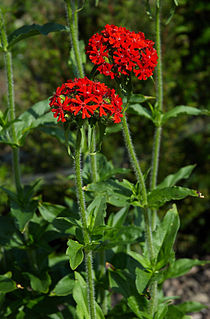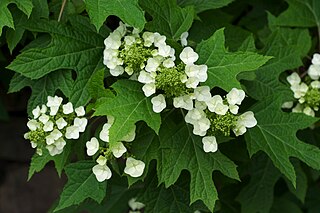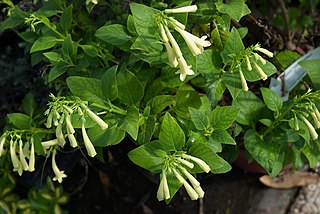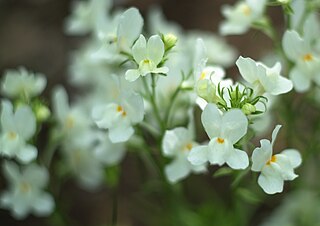
Alstroemeria, commonly called the Peruvian lily or lily of the Incas, is a genus of flowering plants in the family Alstroemeriaceae. They are all native to South America although some have become naturalized in the United States, Mexico, Australia, New Zealand, Madeira and the Canary Islands. Almost all of the species are restricted to one of two distinct centers of diversity, one in central Chile, the other in eastern Brazil. Species of Alstroemeria from Chile are winter-growing plants while those of Brazil are summer growing. All are long-lived perennials except A. graminea, a diminutive annual from the Atacama Desert of Chile.

Hibiscus syriacus is a species of flowering plant in the mallow family, Malvaceae. It is native to Korea, and south-central and southeast China, but widely introduced elsewhere, including much of Asia. It was given the epithet syriacus because it had been collected from gardens in Syria. Common names include the rose of Sharon,, Syrian ketmia, shrub althea, and rose mallow. It is the national flower of South Korea and is mentioned in the South Korean national anthem.

Linaria is a genus of 150 species of flowering plants, one of several related groups commonly called toadflax. They are annuals and herbaceous perennials, and the largest genus in the Antirrhineae tribe of the plantain family Plantaginaceae.

Silene chalcedonica, the Maltese-cross or scarlet lychnis, is a species of flowering plant in the family Caryophyllaceae, native to central and eastern Russia, Kazakhstan, Mongolia and northwestern China. Other common names include flower of Bristol, Jerusalem cross and nonesuch.

Tradescantia pallida is a species of spiderwort similar to T. fluminensis and T. zebrina. The cultivar T. pallida 'Purpurea' is commonly called purple secretia, purple-heart, or purple queen. It is native to the Gulf Coast region of eastern Mexico. Edward Palmer collected the type specimen near Ciudad Victoria, Tamaulipas in 1907.

Hydrangea quercifolia, commonly known as oakleaf hydrangea or oak-leaved hydrangea, is a species of flowering plant in the family Hydrangeaceae. It is native to the southeastern United States, in woodland habitats from North Carolina west to Tennessee, and south to Florida and Louisiana. A deciduous shrub with white showy flower heads, it is grown as a garden plant, with numerous cultivars available commercially.

Salvia splendens, the scarlet sage, is a tender herbaceous perennial plant native to Brazil, growing at 2,000 to 3,000 m elevation where it is warm year-round and with high humidity. The wild form, rarely seen in cultivation, reaches 1.3 m (4.3 ft) tall. Smaller cultivars are very popular as bedding plants, seen in shopping malls and public gardens all over the world.

Lavandula angustifolia, formerly L. officinalis, is a flowering plant in the family Lamiaceae, native to the Mediterranean. Its common names include lavender, true lavender or English lavender ; also garden lavender, common lavender, and narrow-leaved lavender.

Geranium sanguineum, common names bloody crane's-bill or bloody geranium, is a species of hardy flowering herbaceous perennial plant in the cranesbill family Geraniaceae. It is also the county flower of Northumberland.

Salvia pratensis, the meadow clary or meadow sage, is a species of flowering plant in the family Lamiaceae, native to Europe, western Asia and northern Africa. The Latin specific epithet pratensis means "of meadows", referring to its preferred habitat. It also grows in scrub edges and woodland borders.

Bistorta affinis, the Himalayan bistort, fleece flower, or knotweed, is a species of flowering plant in the family Polygonaceae, native to the Himalayas.

Nuttallanthus canadensis, the blue toadflax, Canada toadflax, or old-field toadflax, is a species of Nuttallanthus in the family Plantaginaceae, native to eastern North America from Ontario east to Nova Scotia and south to Texas and Florida.

Phygelius aequalis is a species of flowering plant in the family Scrophulariaceae, native to South Africa. It is a semi-evergreen shrub growing to 1 m (3 ft) tall and wide, with 25 cm (10 in) long panicles of pink flowers with crimson lobes and yellow throats. This species may be distinguished from the closely related Phygelius capensis by the fact that the flowers grow in a single plane along one side of the stem. The narrowly tubular flowers are up to 6 cm (2 in) in length.

Spiraea japonica, the Japanese meadowsweet or Japanese spiraea, is a plant in the family Rosaceae.

Hylotelephium spectabile is a species of flowering plant in the stonecrop family Crassulaceae, native to China and Korea. Its common names include showy stonecrop, iceplant, and butterfly stonecrop.

Linaria bipartita is a species of flowering plant in the plantain family known by the common name clovenlip toadflax. It is native to Morocco, but it can be found elsewhere as an introduced species and it is cultivated as an ornamental plant. It is an annual herb growing 10 to 30 centimeters tall with linear leaves 3 to 5 centimeters in length. The inflorescence is a raceme of flowers occupying the top of the stem. The flower is about 2 centimeters long with five lobes arranged into two lips with a spur at the end. The flower is often reddish purple in color, but flowers of many different colors are bred for the garden. The fruit is a spherical capsule about 2 millimeters wide.

Linaria purpurea is a species of flowering plant in the plantain family known by the common name purple toadflax.

Scilla bifolia, the alpine squill or two-leaf squill, is a herbaceous perennial plant growing from an underground bulb, belonging to the genus Scilla of the family Asparagaceae.

Thymus pulegioides, common names broad-leaved thyme or lemon thyme, is a species of flowering plant in the family Lamiaceae, native to Europe. Growing to 5–25 cm (2–10 in) tall by 25 cm (10 in) wide, it is a small spreading subshrub with strongly aromatic leaves, and lilac pink flowers in early summer. The specific epithet pulegioides highlights its similarity to another species within Lamiaceae, Mentha pulegium (pennyroyal).

Trachelium caeruleum, common name blue throatwort, is a species of flowering plant in the family Campanulaceae native to the Mediterranean, where its native range includes Algeria, Morocco, Portugal, Spain, and Sicily. It has also become naturalized in a few areas, including New Zealand, the Azores, and parts of mainland Europe.




















